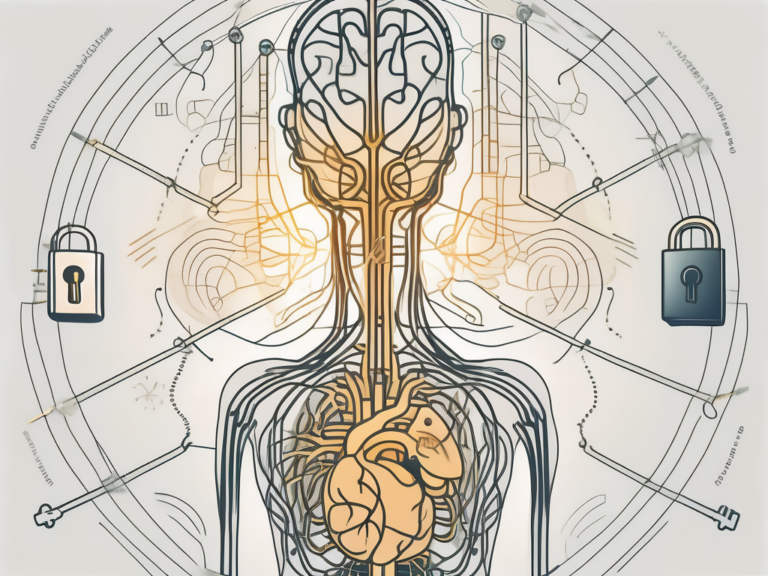Unlocking the Secret Power of the Mandibular Nerve
The mandibular nerve, a crucial component of the trigeminal nerve, holds immense power and significance in the field of dentistry and pain management. Understanding its anatomy, functions, and impact on various oral health conditions is essential for dental professionals and researchers alike. In this article, we will explore the intricacies of the mandibular nerve, its role in pain perception, its implications in dental procedures, disorders related to it, and the future of mandibular nerve research.
Understanding the Mandibular Nerve
The mandibular nerve, also known as the V3 branch of the trigeminal nerve, is a fascinating component of the human nervous system. It is responsible for providing sensory innervation to various structures in the lower face, including the lower jaw, teeth, gums, and the temporomandibular joint (TMJ). This intricate network of nerve fibers allows for the transmission of crucial sensory information that enables us to perceive and respond to various stimuli in our environment.
Anatomy of the Mandibular Nerve
The mandibular nerve originates from the trigeminal ganglion, a collection of cell bodies located within the cranial cavity. From there, it branches out into multiple smaller nerves, each with its own specific functions. One of these branches is the auriculotemporal nerve, which provides sensory innervation to the external ear and the temporal region of the head. Another important branch is the lingual nerve, which supplies sensation to the anterior two-thirds of the tongue. The inferior alveolar nerve, a branch of the mandibular nerve, plays a crucial role in providing sensory innervation to the lower teeth and mandibular bone, ensuring that we can perceive and respond to various stimuli in our oral cavity effectively.
Functions of the Mandibular Nerve
In addition to its sensory functions, the mandibular nerve also contains motor components that are essential for controlling the muscles involved in chewing and biting. This intricate system of nerve fibers allows us to perform essential oral functions with precision and efficiency. Furthermore, the mandibular nerve is responsible for transmitting signals related to temperature, touch, and pain, enabling us to maintain proper oral health and respond appropriately to potential threats or injuries in the oral cavity. The mandibular nerve truly plays a vital role in our daily lives, allowing us to enjoy the pleasures of eating, speaking, and expressing ourselves through facial expressions.
The Mandibular Nerve and Pain Perception
The mandibular nerve, a crucial component of the trigeminal nerve, plays a vital role in pain perception within the oral cavity. Dental professionals are deeply invested in unraveling the complexities of how this nerve functions in transmitting pain signals, as it directly impacts patient care and treatment outcomes.
Role in Transmitting Pain Signals
When the oral tissues experience trauma, inflammation, or infection, the mandibular nerve springs into action. Its intricate network of nerve endings swiftly conveys distress signals to the brain, alerting individuals to potential dental issues. This rapid communication system ensures that any dental problems are promptly addressed, emphasizing the critical role of the mandibular nerve in maintaining oral health.
Implications for Pain Management
The profound understanding of the mandibular nerve’s involvement in pain perception has revolutionized pain management strategies in dentistry. Dentists now possess the knowledge to target specific branches of the mandibular nerve with precision during local anesthesia administration. This targeted approach guarantees effective pain relief during complex dental procedures, fostering a more comfortable experience for patients. By delving deep into the mechanisms of pain perception, dental professionals can tailor treatment plans to enhance patient comfort, alleviate anxiety, and promote overall well-being during dental interventions.
The Mandibular Nerve in Dental Procedures
The mandibular nerve, a major branch of the trigeminal nerve, holds a pivotal role in the realm of dental procedures. Its intricate network of sensory and motor fibers innervates the lower teeth, gums, and lip, making it a crucial element in ensuring successful dental treatments. Dental professionals must delve deep into the anatomy and functions of the mandibular nerve to navigate the complexities of oral care with precision and expertise.
Importance in Dental Surgery
When it comes to dental surgery, the mandibular nerve and its branches take center stage in the meticulous planning and execution of procedures. Dentists and oral surgeons embark on a journey of detailed examination and strategic mapping to safeguard against potential nerve injuries and complications. Utilizing advanced preoperative imaging techniques like cone-beam computed tomography (CBCT) unveils a roadmap of the mandibular nerve’s trajectory, empowering practitioners to perform surgeries with heightened accuracy and minimized risks.
Impact on Anesthesia Techniques
The mandibular nerve’s influence extends to the realm of anesthesia techniques in dentistry, shaping the landscape of pain management strategies. Dentists harness a repertoire of anesthesia methods, including inferior alveolar nerve blocks and lingual nerve blocks, to orchestrate effective pain control for their patients. Profound knowledge of the mandibular nerve’s branching patterns is instrumental in the precise administration of local anesthesia, ensuring a comfortable and pain-free experience for individuals undergoing diverse dental procedures.
Disorders Related to the Mandibular Nerve
A variety of disorders can affect the mandibular nerve, leading to significant discomfort and oral health issues. Dental professionals should be aware of these conditions to provide accurate diagnoses and appropriate treatment plans.
Trigeminal Neuralgia and the Mandibular Nerve
Trigeminal neuralgia, also known as tic douloureux, is a debilitating condition characterized by severe facial pain. The mandibular nerve can be affected by this condition, resulting in excruciating pain in the lower jaw and teeth. It is important to differentiate trigeminal neuralgia from other dental conditions to ensure appropriate management and referral to specialists if necessary.
Mandibular Nerve Neuropathy
Mandibular nerve neuropathy refers to damage or dysfunction of the mandibular nerve. It can cause symptoms such as numbness, tingling, or a burning sensation in the lower jaw, teeth, and gums. Identifying the underlying cause of neuropathy is crucial for devising a comprehensive treatment plan and minimizing the impact on a patient’s quality of life.Expanding on the topic of mandibular nerve disorders, it is essential to highlight the potential causes of such conditions. Trauma to the face or jaw, infections, tumors, or systemic diseases like diabetes can all contribute to mandibular nerve dysfunction. Additionally, dental procedures such as wisdom tooth extraction or root canal treatments may inadvertently damage the mandibular nerve, leading to neuropathic symptoms.Furthermore, the diagnosis of mandibular nerve disorders often involves a thorough clinical examination combined with imaging studies such as MRI or CT scans. These diagnostic tools help in identifying the specific location and extent of nerve damage, guiding treatment decisions. Treatment options for mandibular nerve disorders may include medications to manage pain and inflammation, physical therapy to improve nerve function, or in severe cases, surgical interventions to repair or decompress the affected nerve.In conclusion, understanding the complexities of disorders related to the mandibular nerve is crucial for dental professionals in providing optimal care for patients experiencing such conditions. By staying informed about the latest advancements in diagnosis and treatment modalities, practitioners can effectively alleviate symptoms and improve the overall oral health and well-being of their patients.
The Future of Mandibular Nerve Research
Ongoing research efforts aim to further unlock the potential therapeutic applications and shed light on unanswered questions surrounding the mandibular nerve.
Potential Therapeutic Applications
Researchers are exploring various therapeutic applications of the mandibular nerve, including the use of neuromodulation techniques and targeted drug delivery for pain management. By targeting the mandibular nerve specifically, these treatments may provide more effective and localized pain relief.Moreover, recent studies have shown promising results in utilizing mandibular nerve stimulation for conditions beyond pain management. Researchers are investigating its potential role in enhancing motor function in facial muscles, which could have implications for patients with facial paralysis or other neuromuscular disorders. This innovative approach opens up new avenues for exploring the broader therapeutic benefits of manipulating the mandibular nerve.
Unanswered Questions and Future Directions
Despite significant advancements in our understanding of the mandibular nerve, there are still unanswered questions and areas of further research. Scientists are investigating the molecular mechanisms underlying pain transmission within the mandibular nerve, as well as exploring novel techniques for nerve regeneration. Continued research will undoubtedly contribute to enhanced dental care and improved patient outcomes.Furthermore, emerging technologies such as optogenetics offer exciting possibilities for studying and manipulating the mandibular nerve with unprecedented precision. By harnessing light-sensitive proteins to control nerve activity, researchers can delve deeper into the complexities of neural signaling within the mandibular nerve. This cutting-edge approach has the potential to revolutionize our understanding of nerve function and pave the way for more targeted therapeutic interventions in the future.






